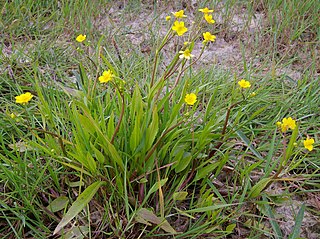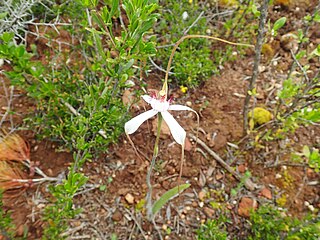
Ranunculus is a genus of about 500 species of flowering plants in the family Ranunculaceae. Members of the genus include the buttercups, spearworts and water crowfoots. The petals are often highly lustrous, especially in yellow species, owing to a special coloration mechanism: the petal's upper surface is very smooth causing a mirror-like reflection. The flash aids in attracting pollinating insects and temperature regulation of the flower's reproductive organs. Buttercups usually flower in the spring, but flowers may be found throughout the summer, especially where the plants are growing as opportunistic colonizers, as in the case of garden weeds.
Mountain skink may refer to:

Ranunculus repens, the creeping buttercup, is a flowering plant in the buttercup family Ranunculaceae, native to Europe, Asia and northwestern Africa. It is also called creeping crowfoot and sitfast.
Eutropis clivicola, known as Inger's mabuya or mountain skink, is a species of skink found in India (Kerala). It was first formally described in 1984 as Mabuya clivicola.
Mogurnda clivicola, commonly known as the Flinders Ranges mogurnda, Flinders Ranges purple-spotted gudgeon, Barcoo, or Bulloo mogurnda, is a central Australian gudgeon of the family Eleotridae.

Ranunculus arvensis, the corn buttercup, devil-on-all-sides or scratch bur, is a plant species of the genus Ranunculus. It is native to Europe, but it can be found on other continents as an introduced species and sometimes a weed, including in North America and Australia. It was formerly a common annual arable weed in Britain, but is now rare there. It is most often found in moist places, such as spring puddles in meadows.
A mallet is a small-tree form of Eucalyptus found in Western Australia. Unlike the mallee, it is single-stemmed and lacks a lignotuber. Trees of this form have a relatively long, slender trunk, steeply-angled branches, and often a conspicuously dense terminal crown, and sometimes form thickets.

Ranunculus flammula, the lesser spearwort, greater creeping spearwort or banewort, is a species of perennial herbaceous plants in the genus Ranunculus (buttercup), growing in damp places throughout the Boreal Kingdom. It flowers June/July. Ranunculus flammula is poisonous. It is very closely related to R. reptans, which is distinguished by prostrate and more slender stems, narrower leaves and smaller flowers and is sometimes included within R. flammula sensu lato as a variety.
Ranunculus papulentus, commonly known as the large river buttercup, is a buttercup that is endemic to south-eastern Australia.

Ranunculus sardous is a species of buttercup known by the common name hairy buttercup. It is native to Europe and it can be found in many other areas of the world, including parts of the United States and Australia, as an introduced species and a roadside and lawn weed. It grows in many types of disturbed habitat, especially in moist areas. It is an annual or biennial herb producing a mostly erect, hairy stem up to half a meter tall. The hairy leaves are usually divided into three leaflets which are borne on petioles a few centimeters in length. The flower has usually five yellow petals each up to a centimeter long and five reflexed sepals. The fruit is an achene borne in a spherical cluster of up to 35.
Ranunculus crassipes is a small flowering plant in the buttercup or crowfoot family Ranunculaceae that is native to the subantarctic region. The specific epithet comes from the Latin and refers to the plant’s thicker and more succulent form compared to the closely related R. biternatus.

Ranunculus lappaceus, commonly known as the common buttercup, Australian buttercup or Yarrakalgamba, is found across eastern Australia. Like buttercups elsewhere, it is a perennial herb with yellow flowers appearing in spring and summer.

Ranunculus acaulis, in Australia and New Zealand called dune buttercup, sand buttercup or shore buttercup, is a yellow-flowered, small, fleshy herb, that grows in mats in damp places mostly near the sea. It occurs naturally in Australia, New Zealand, Chile and the Falklands. It flowers between August and April and sets seed from September till July.
Ranunculus anemoneus, commonly known as the anemone buttercup, is an endangered species of buttercup found in alpine Australia.

Ranunculus inundatus, commonly known as the river buttercup, is a species of buttercup found in eastern Australia.
Ranunculus dissectifolius is a rare species of buttercup found in alpine Australia.

Eucalyptus clivicola, commonly known as green mallet, is a species of eucalypt that is endemic in Western Australia. It has smooth bark, linear to lance-shaped adult leaves, flower buds in groups of between nine and thirteen, pale yellow flowers and barrel-shaped, conical or cylindrical fruit.

Caladenia longicauda subsp. clivicola, commonly known as the Darling Scarp white spider orchid, or hills white spider orchid is a plant in the orchid family Orchidaceae and is endemic to the south-west of Western Australia. It has a single hairy leaf and up to three mostly white flowers with long, drooping lateral sepals and petals, a relatively small, narrow labellum and narrow labellum teeth. It grows in a restricted area, mostly on the Darling Scarp.
Pterostylis clivicola is a plant in the orchid family Orchidaceae and is endemic to a small area near the border between New South Wales and Victoria. It has a rosette of leaves and up to fourteen green flowers which have a labellum with a dark green, beak-like appendage.

Genoplesium clivicola, known as Corunastylis clivicola in Australia, is a small terrestrial orchid endemic to south-eastern Australia. It has a single thin leaf fused to the flowering stem and up to twenty five small, greenish and reddish flowers. It grows in forest and woodland in Victoria, the Australian Capital Territory and New South Wales.










